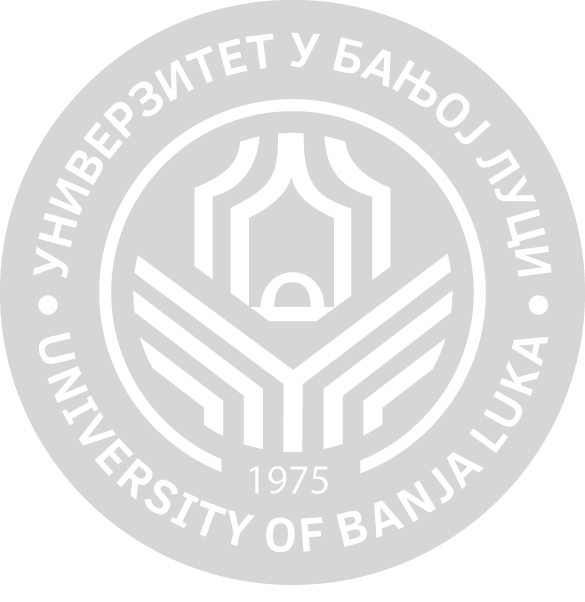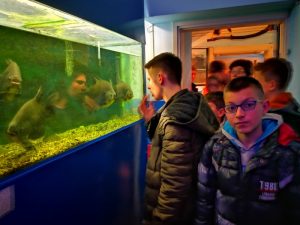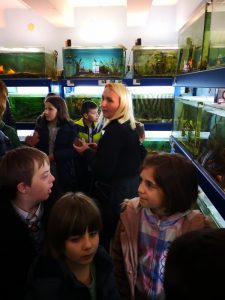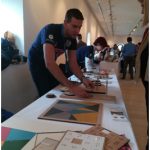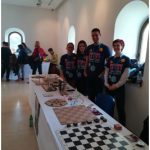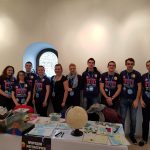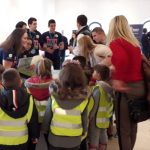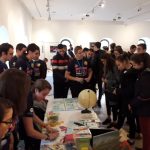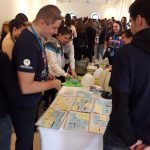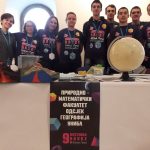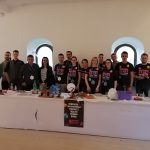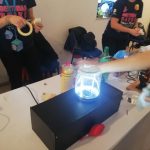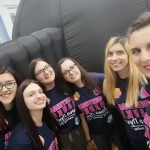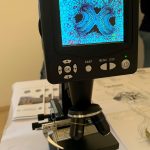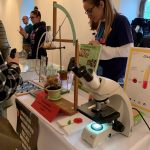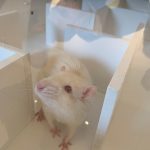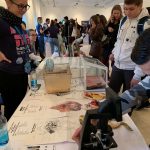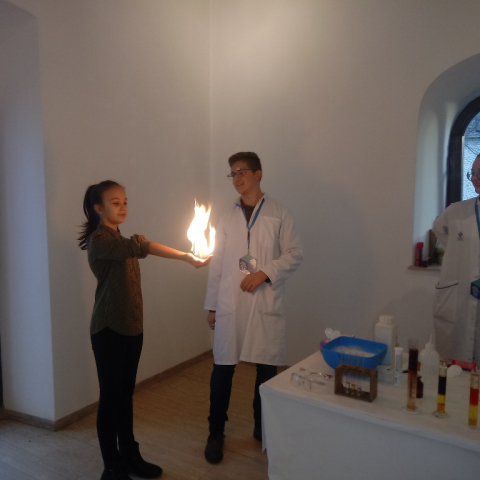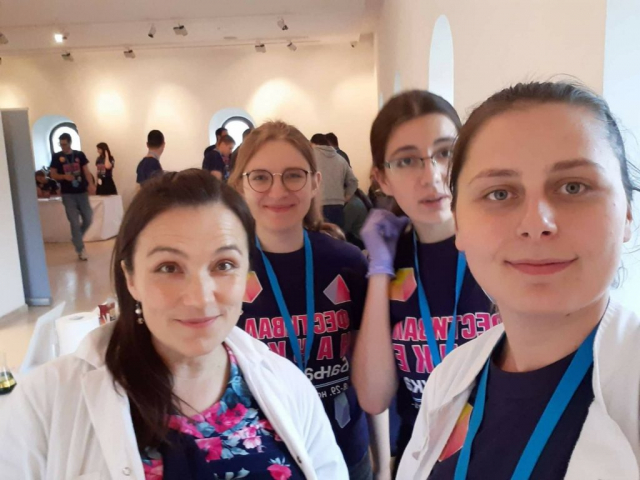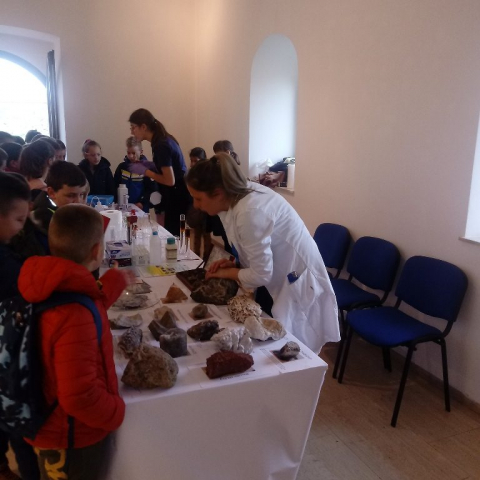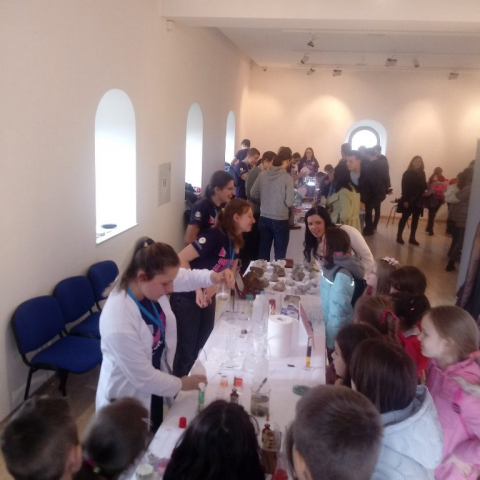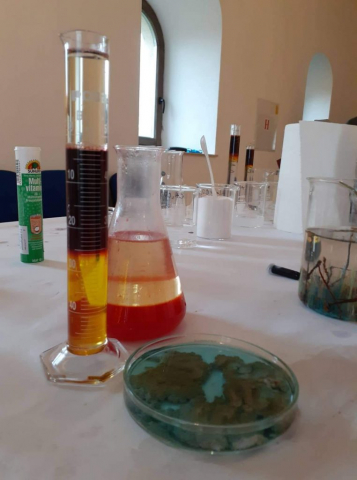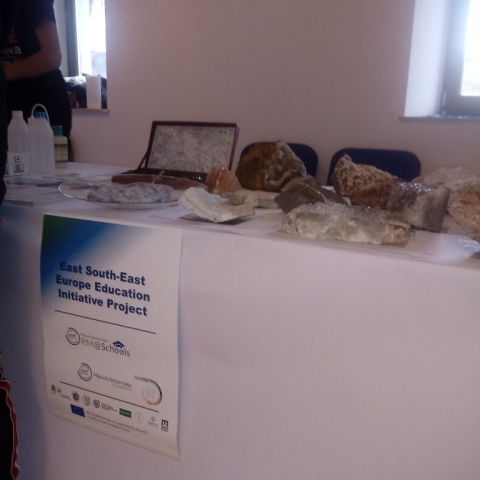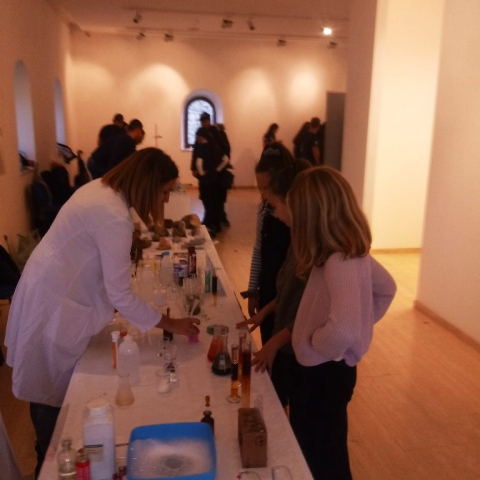



Kao i prethodnih godina studenti i nastavno osoblje Prirodno-matematičkog fakulteta su aktivno učestvovali na Festivalu nauke koji organizuje Ministarstvo za naučnotehnološki razvoj, visoko obrazovanje i informaciono društvo Republike Srpske. Festival je trajao dva dana, 28.-29. novembar i bio je odlična prilika da se promovišu prirodne i tehničke nauke djeci i mladima. Naš Fakultet je bio u mogućnosti da promoviše svoj naučno-istraživački rad finasiran značajnim dijelom iz sredstava Ministarstva ali takođe i iz fondova okvira Horizon 2020 (kao što su COST, EIT RawMaterials) te programa Erasmus+.
Pored Planetarijuma, gdje su, prvenstveno učenici nižih razreda mogli da uživaju u projekciji zvjezdanog neba, simulaciji kretanja planeta, simulaciji crne rupe
i Javnog Akvarijuma, sa karakterističnim predstavnicima naših, ali i tropskih slatkih voda,
posjetiocima su se predstavili studijski programi:
MATEMATIKA I INFORMATIKA,
Volonteri Studijskog programa matematika i informatika su posjetiocima pomagali da riješe brojne matematičke mozgalice poput tangrama, ikosaedra, hanojskih kula, postavljanja 8 kraljica na šahovsku tablu.
GEOGRAFIJA
Nastavnici i saradnici zajedno sa studentima sa Studijskog programa geografije predstavili su izazove i primjenu ove nauke u praksi, prilagođavajući se različitim uzrastima posjetilaca Festivala. Najmlađi posjetioci su kroz igru plastelinom naučili kako nastaje vulkan, koji su to osnovni elementi reljefa te iz kojih oblaka se mogu očekivati padavine. Oni malo stariji imali su priliku da provjere svoje znanje iz političke geografije, kartografije i geografije Evrope i svijeta kroz niz zanimljivih radionica. Posjetiocima su predstavljani prirodnogeografski i društvenogeografski potencijali Bosne i Hercegovine (s akcentom na Republiku Srpsku), kao razvojne mogućnosti. Takođe, ukazivano je i na rizike u geografskom prostoru i na načine njihovog sprečavanja.
FIZIKA
U Kamenoj kući u Kastelu predstavljeno je čak 19 eksperimenata. Studenti svih godina, zajedno sa veoma posvećenim laborantima sa ovog studijskog programa, pokušali su djeci i zainteresovanima da približe svijet nauke i pokažu koliko je Fizika zanimljiva.
EKOLOGIJA I ZAŠTITA ŽIVOTNE SREDINE
BIOLOGIJA
Posjetiocima je omogućeno da vide čudesni svijet naših izvora, aparat za mjerenje rasta biljaka, biljku mesožderku, prolazak laboratorijskog pacova kroz lavirint, krvne elemente, usni aparat različitih insekata, da izmjere veličinu i broj stoma na naličju lista i slično.
HEMIJA
Prezentacija SP Hemija uključivala je naučno-popularne eksperimente sa rastvorima metalnih jona. Takođe se fokusirala se na promociju izvanrednih geoloških potencijala naše Republike i cijele zemlje te izložila kolekciju živopisnih minerala koje su im darovali kolege geolozi. Posjetioci su bili iznenađeni da saznaju kolike su rezerve željeza (50 miliona tona u bazenu Ljubija), boksita (preko 30 miliona tona na istoku Republike), poludragog kamena opala (koga imamo u Dobojskoj regiji), pirofilita (38 miliona tona u Parsovićima), kaolina (100 milona tona u oblasti Srpca) i mnoge druge.
Ovaj studijski program je takođe promovisao i svoje učešće u projektu East South East Education Initiative, finansiran od strane fonda EIT RawMaterials kroz koji se upravo i podiže svijest mladih Evropljana o prirodnim bogatstvima njihovih zemalja. Cilj je da učenici kroz metodologiju programa RM@schools („Minerali u školama“), zavole ovu oblast i studiraju kasnije oblasti nauka o materijalima (hemija, geologija, tehnologija, geografija…) kako bi doprinijeli većoj nezavisnosti Evrope od uvoza sirovina sa drugih kontinenata. SP hemija u većini svojih istraživanja upravo i koristi domaće mineralne i poljoprivredne sirovine i otpad.
Faculty of Natural Sciences and Mathematics at the Festival of Science 2019
Just like in previous years, students and teachers from the Faculty, actively participated in the Festival of Science, organized by the Ministry of Scientific-Technological Development, Higher Edcuation and Information Society. Festival lasted for two day, November 28 and 29, and it was a great opportunity to promote natural and technical science to the children and youth. Our Faculty was able to promote its scientific research which is financed in large part by the Ministry support, but also through the funds from the Horizon2020 Framework (like COST, EIT RawMaterials) and also by Erasmus+.
Beside the Planetarium, where the pupils could enjoy the projection of the stars in the sky, simulation of the planets’ movements and the black hole,
but also the Public Aquarium with the characteristic representatives of our local, but also the tropical water animals, the visitors could the see the presentations of the study programmes.
MATHEMATICS AND INFORMATICS
Volunteers from the Study Programme Mathematics and Informatics, were helping visitors to solve numerous, mathematical puzzles and problems, such as tangram, icosahedra, Hanoi towers, setting of the 8 queens on the chess board and many more.
GEOGRAPHY
Teachers and assistants, together with students, from this study programme presented some challenges in application of this scientific area in practice, adapting the presentation style to the different ages of the visitors. The youngest visitors played with the clay and were making the model of volcano, they also learned how the atmospheric precipitation is generated in nature. The older visitors, could check their knowledge in political geography, cartography, and geography of the Europe and the world, through different workshops. The visitors, were presented with natural geography, and social geography potentials of the Republic and the country as a whole, as the development potentials. At the same time, the presentations stressed some risks on the geographical areas and how can they be prevented or avoided.
PHYSICS
This study programme presented as many as 19 different experiments to the audience in the Stone House. Students, together with the dedicated technicians from this study programme, tried to make children and other visitors more familiar with the interesting world of physics.
ECOLOGY AND PROTECTION OF THE ENVIRONMENT, BIOLOGY STUDY PROGRAMMES
The visitors could see the magical world of our springs, the equipment for the plant growth measurement, meat-eating plant, the exercises of the laboratory rats, the blood elements, the mouth mechanism of different insects and they could also measure the size and the number of stomas on the leaf backside.
CHEMISTRY
Presentation of the Study programme Chemistry, included the scientific-popular experiments with the solutions of metal ions. Also, they focused on the promotion of the excellent geological potentials of our Republic and the country as a whole, by showing the collection of the colourfull minerals given to them by the colleague geologists. The visitors were surprised to learn how large are the deposits of iron (over 50 million tons in the Ljubija basin), bauxite (over 30 million tons in the east part of the Republic, the semiprecious stone opal (we have it Doboj region), pyrophyllite (38 milliona tona in Parsovići), caoline (over 100 million tons in Srbac region) and many more. This study programme has also promoted their participation in the East South East Education Initiative project financed by EIT RawMaterials, which is exactly about the promotion of the awareness of young Europeans about the natural recourses of their countries. The goal of the project is to use the methodology RM@schools to increase the interest of the pupils for the material sciences (chemistry, geology, technology, geography…). This way they should give their contribution in making Europe less dependent on the raw materials from other continents in the future. Study programme Chemistry is doing it also by having the domestic mineral resources and the waste as the dominant subject of their recent research.
